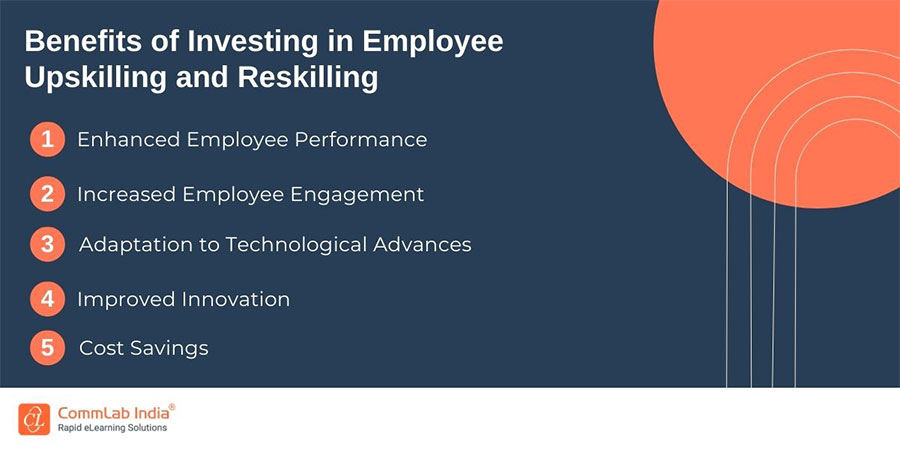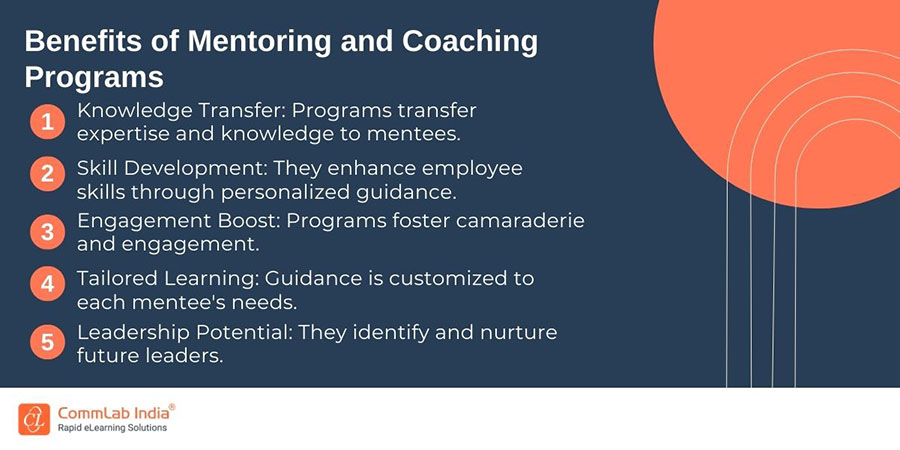How Employee Upskilling and Reskilling Benefits Your Company

In today’s dynamic business landscape, investing in employee upskilling has emerged as a key driver of success for businesses large and small. By empowering your workforce with new skills and knowledge, you not only boost their individual growth but also fuel your company's overall prosperity.
Join us as we dive into why prioritizing employee upskilling is no longer just a nice-to-have but a critical strategy for future-proofing your organization. Explore with us the myriad benefits that await those who dare to invest in unlocking their team's potential! The blog also discusses different ways to implement them including microlearning and VILT.
Implementing Employee Upskilling and Reskilling Initiatives Offer Undeniable Benefits.
Some popular methods to implement successful initiatives include:
- Custom eLearning
- VILT (Virtual Instructor-Led Training)
- Microlearning
- Mentoring and Coaching Programs
- Job Shadowing
Employee Upskilling and Reskilling
Upskilling and reskilling are indispensable components of a modern organization's talent development strategy. Upskilling refers to enhancing the existing skills of employees, enabling them to perform their current roles more effectively. Reskilling, on the other hand, involves training employees with entirely new skills to take on different roles within the company, often in response to changing business needs.
By investing in these processes, companies empower their workforce to adapt to evolving technologies, industry trends, and market demands. This not only enhances the employees' job satisfaction and career growth but also strengthens the organization's overall competitiveness.
Benefits of Investing in Employee Upskilling and Reskilling

1. Enhanced Employee Performance: Upskilled employees perform their tasks more efficiently and effectively, leading to improved productivity and higher-quality work.
2. Increased Employee Engagement: Investing in professional development shows employees that their growth and well-being are valued, resulting in higher job satisfaction and lower turnover rates.
3. Adaptation to Technological Advances: Continuous upskilling ensures that your workforce remains competent and capable of leveraging new technologies, keeping your company competitive.
4. Improved Innovation: Well-trained employees are more likely to come up with innovative solutions and ideas, contributing to the company's overall creativity and competitiveness.
5. Cost Savings: Upskilling existing employees is often more cost-effective than hiring and onboarding new ones. Trained employees also require less supervision, reducing operational costs.
→ Download Now: How L&D And Business Can Align to Conquer The Future Of Work [eBook]
Ways to Implement Employee Upskilling and Reskilling Initiatives
Now, let's talk about some practical methods to implement effective upskilling and reskilling initiatives in your organization:
1. Custom eLearning
Custom eLearning solutions offer tailored content that precisely matches your company's needs and objectives. These programs are interactive, engaging, and can be accessed anytime, anywhere. They allow employees to learn at their own pace, making it a flexible and efficient choice for upskilling.
VILT (Virtual Instructor-Led Training)
VILT combines the benefits of traditional classroom training with the convenience of remote learning. It involves real-time interaction with instructors and fellow learners through virtual platforms. VILT sessions can be recorded for future reference, ensuring that employees have access to valuable training resources.
Microlearning
Microlearning breaks down training content into small, easily digestible modules. This approach suits employees' busy schedules and short attention spans. Microlearning provides quick bursts of information, allowing employees to acquire new skills incrementally.
Mentoring and Coaching Programs
Pairing experienced employees with those who need guidance can be highly effective. Mentoring and coaching programs foster knowledge transfer, skill development, and a sense of camaraderie within your organization. This peer-to-peer learning approach can be a valuable component of your upskilling strategy.

Job Shadowing
Job shadowing involves allowing employees to observe and learn from colleagues in different roles. It provides a hands-on understanding of various job functions and encourages cross-functional knowledge exchange. Job shadowing can be particularly useful when reskilling employees for new positions.
Summing Up
Investing in employee upskilling and reskilling isn't just an option; it's a necessity for organizations aiming to thrive in today's competitive environment. The benefits are clear: improved employee performance, engagement, adaptability, innovation, and cost savings.
Ready to unlock the full potential of upskilling and reskilling for your organization's success? Dive deeper into the strategies and insights that bridge the gap between Learning and Development (L&D) and business goals. Download our comprehensive eBook, 'How L&D And Business Can Align to Conquer The Future Of Work,' today. Discover the keys to creating a future-ready workforce and stay ahead in a rapidly changing business landscape.





![Get Your Top Management to Say Yes to Mobile Learning! [eBook]](https://blog.commlabindia.com/hubfs/Imported_Blog_Media/mobile-learning-implementation-ebook-v2.png)